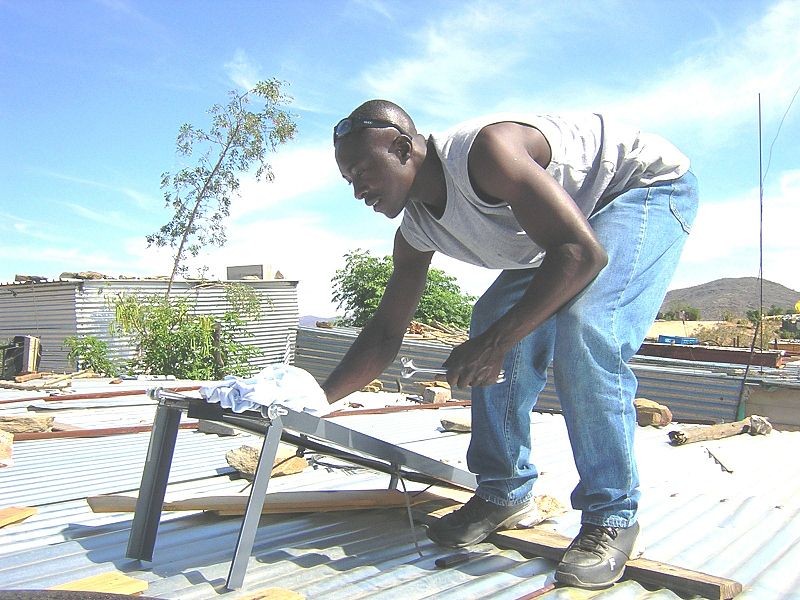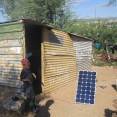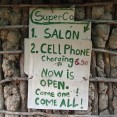To encourage entrepreneurship and enhance access to modern energy services in the off-grid rural and informal settlements of Namibia

The objective of the project was to promote business opportunities in the off-grid regions of Namibia. The established "Energy Shops" can provide basic energy services and foster renewable energy technologies. Ten suitable entrepreneurs were identified, trained and equipped with solar business systems that offer electricity for cell phone charging, hair cutting, electric lantern charging and lighting. In addition, the businesses were provided with solar and energy efficient stoves for backing and catering.
The Desert Research Foundation of Namibia (DRFN), who implemente the project, monitored the technical and economic performance of the systems and social implications. DRFN concluded that the concept is viable and developed several recommendations for a larger scale implementation to ensure the financial feasibility and sustainability of small Energy Shops in the future.
Background
In Namibia, over 60% of the population does not have access to grid electricity, which is hindering the country's economic and societal growth. For off-grid regions, the establishment of "Energy Shops" can provide basic energy services, foster renewable energy technologies and enhance small-scale business opportunities.
In a thorough selection process, ten suitable entrepreneurs were identified in rural or informal settlements in six regions across Namibia with different local conditions. After undergoing training in technical operations and business management, the entrepreneurs were equipped with solar business systems that can supply electricity for mobile phone charging, hair cutting, electric lantern charging and lighting. In addition, the businesses were provided with solar and wood-saving stoves for baking and catering.
The organization in charge of implementing this project, Desert Research Foundation of Namibia (DRFN), monitored the technical and economic performance of the systems and social implications of the shops over a six-month period. They concluded that the concept is viable and developed several recommendations for a larger scale implementation to ensure the financial feasibility and sustainability of small Energy Shops in the future.
The lessons learned will provide feedback for the government's "Off-Grid Energisation Master Plan" (OGEMP) of Namibia, which had already proposed the establishment of solar powered Energy Shops.
Technology, Operations and Maintenance
Two types of solar systems from Namibian solar companies were provided. Each consisted of an 80W solar panel, a 12V battery and a 200W inverter. They have an AC and a DC power strip and ten assorted DC mobile phone chargers. The system has the capacity to charge ten mobile phones at once.
Furthermore, the shops were equipped with a hair clipper, which can run for two hours a day, two wired lights, each with an operation time of three hours per day, and two portable LED lanterns. The systems were designed to be plug-and-play and, therefore, were easily installed in the shops. The participants were technically trained in the operation of the system.

On cloudy days some of the systems did not generate sufficient electricity for phone charging and would, therefore need another solar panel or battery to run properly all year round. The improper use of the system resulted in damage to a converter and fast draining of the battery. These experiences highlighted the need for improving the training and knowledge about the capability of the system and battery, as well as further developing the options for system expansion.
Financial Issues and Management
Each solar system costs around 12,000N$ (~1300€). In this demonstration project, the selected entrepreneurs received the solar system for free, after they had submitted an energy profile of their region and attended a business management course. They were also required to submit monthly financial records to DRFN for monitoring purposes.
The shop owners were permitted to set prices at their own discretion, which varied from around 3-5N$ for mobile phone charging and 10 – 20N$ for hair cutting. Based on the data of the 10 systems, the detailed profits gained through the use of the PV systems could be assessed to analyse performance and viability. They varied from 50N$ to over 3000N$ for mobile phone charging per month in the first half year. The income is clearly dependent on local conditions (e.g. distance from grid, range of products offered in the shop, business experience of the owner, publicity & advertising, shop design).
With a 5% fixed yearly interest rate, the entrepreneurs would be able to repay the system after five years or less, assuming that they could afford to repay 250N$ per month. However, not all shops generated this amount on PV services. The shops with lower income were given advice on how to improve their business.
Environmental Issues
By using solar energy for charging mobile phones and other devices, less fossil fuel based electricity is used, with the result that the CO2 emissions are reduced by around 1,500 kg per year.Additionally, the reduction in the use of kerosene lamps should also mean that there is a positive impact on health. The only negative environmental impacts are related to the production and later disposal of the solar cells and batteries.
Social Issues
The Energy Shops offer business opportunities for the entrepreneurs and improve access to energy services for people with no grid connection. As the systems were purchased from local suppliers, the project also gave a boost to the local market for PV systems. However, in some communities, the Energy Shops had local business competitors, which resulted in envy.
The access to charging services also influenced other services provided by the entrepreneurs. For example, a small bar run by one entrepreneur was able to extend ist opening hours thanks to improved lighting, which both influenced the social life of the community and, simultaneously, improved the entrepreneur's profits from the solar charging.

Results & Impact
The results are greatly dependent on the different conditions of each location. The shop that is farthest away from the grid and offers several non-energy products in addition to the charging services was the most successful in the first six months.

The separation of an owner's shop and home is also significant in influencing the success of the business, and advertising and business know-how are also important factors. Marketing was not always sufficient which was, in part, due to the fear of theft of the systems. However, the shops that are not yet economically viable do have the potential to improve their business in the future.
Replicability
The project is highly replicable. It is expected that the implementation of the four MFP demonstration models will especially influence the neighboring villages and the public. Considering that studies had been done for a community in each region, the replicability costs will be lower. Only the MFPs have to be purchased and operators have to be trained.
The recent East African Community (EAC) Regional Energy Access Scale-up Strategy explicitly recognized the MFP concept as having a unique applicability in the region.The knowledge that has been gained from the projects is collected and distributed more widely to both national and regional stakeholders as well as future potential donors.
Lessons learned
Based on the monitoring data and an onsite interview, the following recommendations were developed for the implementation of a large-scale Energy Shops programme in Namibia:
- Market assessment survey of the community prior to implementation in order to understand the local energy service demand;
- Preference should be given to shops located far away from the grid;
- System operation should be separate from the entrepreneur's home;
- Entrepreneurs should have business training;
- The attendance of a training course to understand the system should be mandatory and haircutting training should be an integral part of this course;
- A broad portfolio of services or non energy products is recommended in addition to charging services; and
- Signage advertisement and word-of mouth advertisement is a requirement.